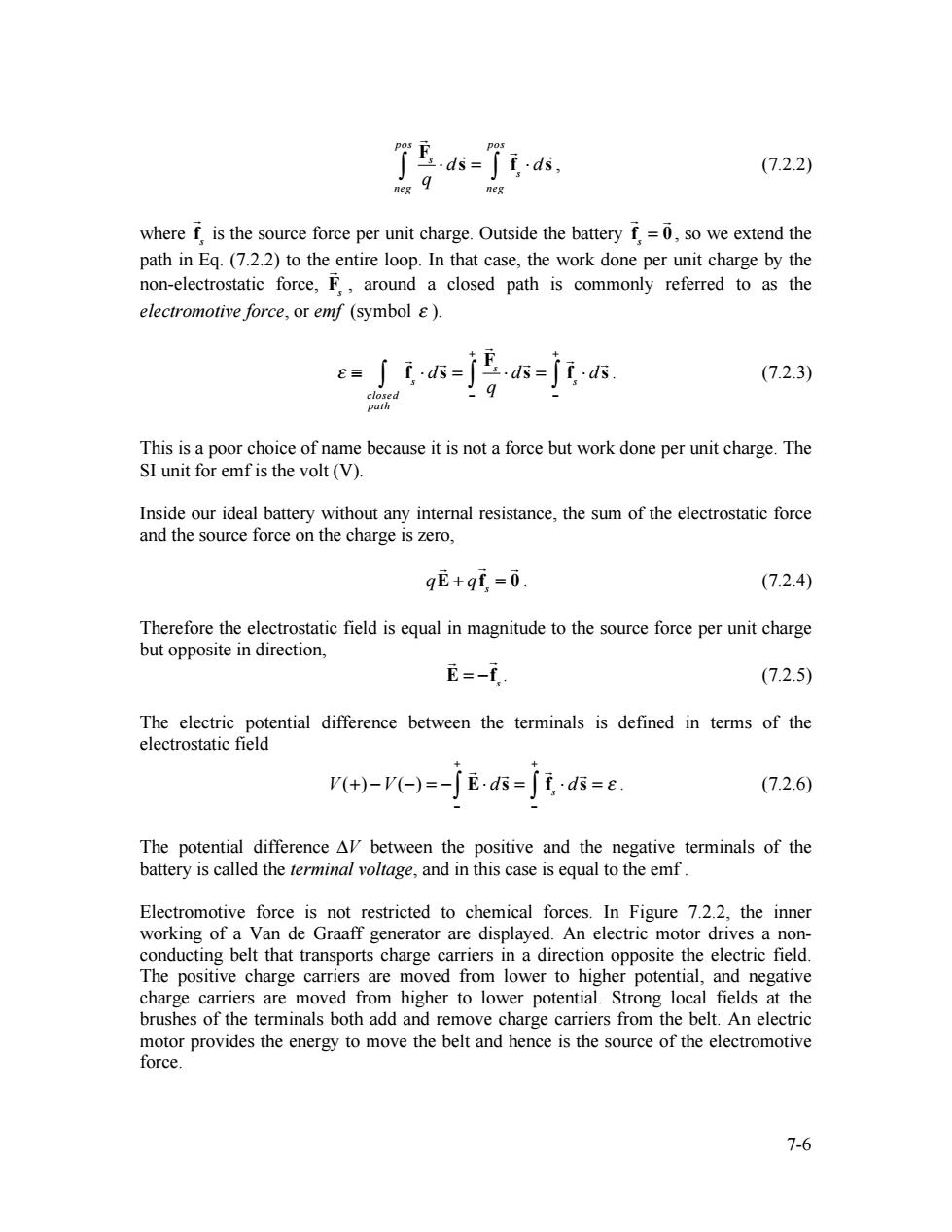正在加载图片...

了s=了is (7.2.2) neg g neg where f is the source force per unit charge.Outside the battery f=0,so we extend the path in Eq.(7.2.2)to the entire loop.In that case,the work done per unit charge by the non-electrostatic force,F,around a closed path is commonly referred to as the electromotive force,or emf (symbol s). i-j语6-js (7.2.3) path This is a poor choice of name because it is not a force but work done per unit charge.The SI unit for emf is the volt (V). Inside our ideal battery without any internal resistance,the sum of the electrostatic force and the source force on the charge is zero, qE+qf=0 (7.2.4) Therefore the electrostatic field is equal in magnitude to the source force per unit charge but opposite in direction, E=-f. (7.2.5) The electric potential difference between the terminals is defined in terms of the electrostatic field r(+)-(-)=-∫Es=∫is=e (7.2.6) The potential difference Al between the positive and the negative terminals of the battery is called the terminal voltage,and in this case is equal to the emf. Electromotive force is not restricted to chemical forces.In Figure 7.2.2,the inner working of a Van de Graaff generator are displayed.An electric motor drives a non- conducting belt that transports charge carriers in a direction opposite the electric field. The positive charge carriers are moved from lower to higher potential,and negative charge carriers are moved from higher to lower potential.Strong local fields at the brushes of the terminals both add and remove charge carriers from the belt.An electric motor provides the energy to move the belt and hence is the source of the electromotive force. 7-67-6 Fs q ⋅ d s neg pos ∫ = fs ⋅ d s neg pos ∫ , (7.2.2) where fs is the source force per unit charge. Outside the battery fs = 0 , so we extend the path in Eq. (7.2.2) to the entire loop. In that case, the work done per unit charge by the non-electrostatic force, Fs , around a closed path is commonly referred to as the electromotive force, or emf (symbol ε ). ε ≡ fs ⋅ d s closed path ∫ = Fs q ⋅ d s − + ∫ = fs ⋅ d s − + ∫ . (7.2.3) This is a poor choice of name because it is not a force but work done per unit charge. The SI unit for emf is the volt (V). Inside our ideal battery without any internal resistance, the sum of the electrostatic force and the source force on the charge is zero, q E + q fs = 0 . (7.2.4) Therefore the electrostatic field is equal in magnitude to the source force per unit charge but opposite in direction, E = − fs . (7.2.5) The electric potential difference between the terminals is defined in terms of the electrostatic field V (+) −V (−) = − E⋅ d s − + ∫ = fs ⋅ d s − + ∫ = ε . (7.2.6) The potential difference ΔV between the positive and the negative terminals of the battery is called the terminal voltage, and in this case is equal to the emf . Electromotive force is not restricted to chemical forces. In Figure 7.2.2, the inner working of a Van de Graaff generator are displayed. An electric motor drives a nonconducting belt that transports charge carriers in a direction opposite the electric field. The positive charge carriers are moved from lower to higher potential, and negative charge carriers are moved from higher to lower potential. Strong local fields at the brushes of the terminals both add and remove charge carriers from the belt. An electric motor provides the energy to move the belt and hence is the source of the electromotive force